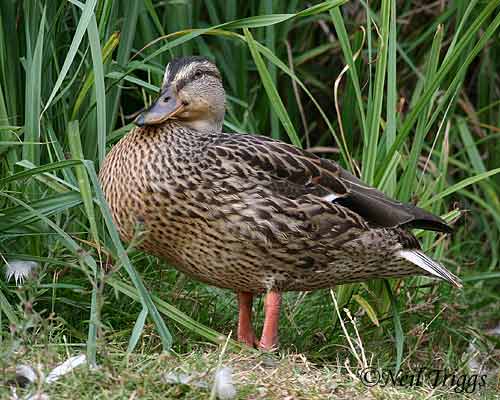Duck - Mallard
Scientific Name: Anas platyrynchos
Sat, 26th April, 2025 - 5:09 pm GMT
Sponsor Ads:

Alternative Name
Scientific Name: Anas platyrynchosBasic Info
Mallard Ducks usually weigh around two and a half pounds (just over a kilogram), and measures about 25 inches (between 50 and 62 centimeters) in length. Females are less striking in appearance than males. They have brown beaks, and their feathers are usually brown and straw colored. Males, called drakes, particularly during breeding season, show beautiful iridescent coloration. Their plumage is rust colored to gray, and their chests are chestnut brown. A white ring collars the neck of the male Mallard Duck, separating his brown or gray plumage from his upper neck and head. His head and breast are often iridescent, and the head and neck often have a remarkable green sheen. Many times blue, purple, and rich chestnut colored feathers also accent the top portions of male Mallards. His tail feathers are often curly. The legs of both sexes are reddish orange, and both sexes have royal blue speculums that are defined by white tracing.
Health
Mallard Ducks require an area with both land and water regions. Most enjoy a bath daily, and fresh water should be provided at all times. They usually eat a diet based on insects, often mealworms, supplemented with fresh greens. Many are fed on a standard domestic bird pellet food. Treats can be offered in the form of bits of bread, cooked pasta, or other soft carbohydrate foods. Ducklings should have their food mixed with water to soften it into a mush. Male Mallard Ducks molt twice yearly, once acquiring duller plumage, and once acquiring the brighter breeding plumage that includes the iridescent green feathering of the head. Young Mallard Ducks are hatched without waterproofing oils on their feathers. They acquire these oils as they grow older, and while they are young, oil transferred from their parents during grooming waterproofs them. If you have a duckling and no parent, you should not get your duckling wet. Breeding Mallard Ducks usually nest in March, though by autumn most have formed pairs. They use nests located on the ground, made from leaves, grass, and other vegetation and lined with feathers. Often, these nests may be located away from water. The eggs are usually a green color, ranging from olive green to blue green. Between 8 and 12 eggs are laid in an average clutch, and they require between 22 and 30 days of incubation by the hen, or female Mallard Duck, before they hatch. Normally drakes have little to do with the ducklings, and the female will lead them to the water once they have hatched. Usually the drake will have abandoned the family during the first week of incubation. The hatching of Mallard ducklings usually occurs between the end of March and July. By the time they are about two months old, the little Mallard Ducks begin to fly.Habitat
often seen in canals, lakes, ponds, and urban parksBehavior
Mallard Ducks are a familiar sight to many people in a large area of the world. These beautiful birds live in both urban and rural areas. They are large and not overly shy; many people enjoy offering them bread or other treats when they see Mallard Ducks. Not overly disturbed by human activity, Mallard Ducks are often seen in canals, lakes, ponds, and urban parks. They seem to be able to adapt well to nearly anywhere with a body of freshwater and an appropriate climate. Mallard Ducks are migratory, spending winters in more southern regions and summering in northerly parts of their range. In warmer areas of the world, some Mallard Ducks may not migrate. In the fall and winter, they pair into mated couples. Although females quack, males do not; rather, they communicate with whistling or grunting noises. Mallard Ducks spend most of their time foraging for food.Most of this food is acquired from foraging in muddy areas in or near the water and embankment of the Mallard Duck's home. The Mallard Duck uses its bill to filter food from the mud.Origin
Northern HemisphereHistory
Mallard Ducks are found in many areas of the world, including North and Central America, Africa, Asia, and Europe. They are a sight often enjoyed by park goers or bird enthusiasts, and many are kept in captivity. However, some people do not welcome the arrival of Mallard Ducks, as these birds can damage grain crops. Most breeds of domestic ducks were breed from the Mallard. Several were developed in China thousands of years ago, such as the Runner and Pekin Ducks. They are seen in ancient Chinese art. They only domestic breed not from the Mallard is the Muscovy.Common Foods
They eat a number of items including insects, fish eggs, small fish, tadpoles, wild rice, berries, leaves, green plant shoots, and grain.Sponsor Ads:
Listen to the gods speak. `cat /proc/kcore > /dev/audio`
Duck - Mallard
Coded by: BGID® | ALL RIGHTS RESERVED Copyright © 2000-2025
Disclaimer | Privacy | Report Errors / Contact | Credits


 President of the United States of America - Real Estate mogul, Pageant owner and now one of the most controversial men in political history.
President of the United States of America - Real Estate mogul, Pageant owner and now one of the most controversial men in political history.  Politician, US Vice President and President of the USA - Joseph Robinette Biden Jr.
Politician, US Vice President and President of the USA - Joseph Robinette Biden Jr.  versus
versus  Russia: 'The Evil Empire'? Are they all that bad or is it just the USA trying to portray Russia as bad because they are a world power with land bigger and a society very different from the USA ideal?
Russia: 'The Evil Empire'? Are they all that bad or is it just the USA trying to portray Russia as bad because they are a world power with land bigger and a society very different from the USA ideal?  Global warming has been in and out as the "latest" hot topic for many years. It is, according to modern scientists, the result of man-made industrial pollutants, clearing forested areas, agriculture, etc. But now they are thinking it started way before the Industrial Revolution...
Global warming has been in and out as the "latest" hot topic for many years. It is, according to modern scientists, the result of man-made industrial pollutants, clearing forested areas, agriculture, etc. But now they are thinking it started way before the Industrial Revolution... 
 Corona virus
Corona virus 
 Users with wide screen monitors can benefit from more content on every page.
Users with wide screen monitors can benefit from more content on every page.